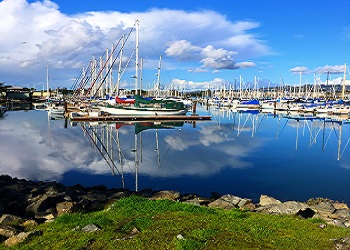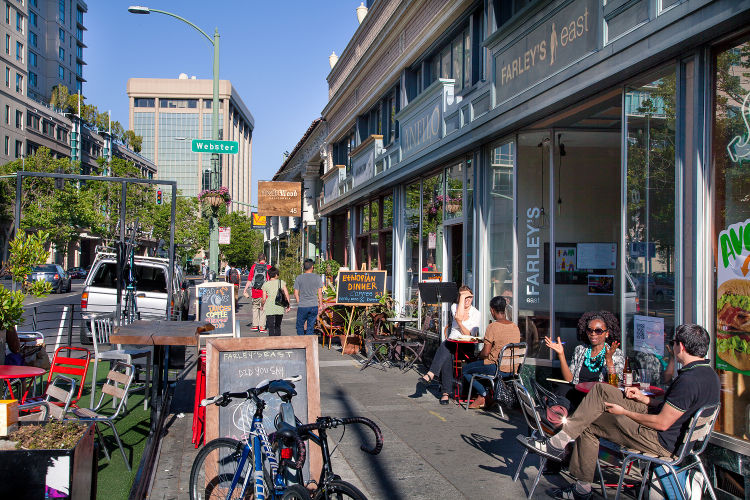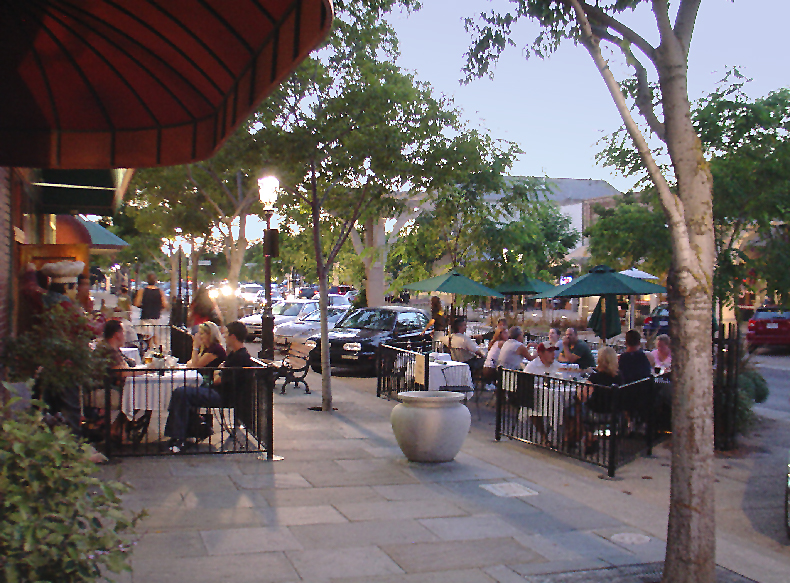Local Neighborhoods
The Bay Area is a very diverse place consisting of many vibrant communities. Whether you feel most at home in an urban environment, or prefer a more rural setting, there is a good chance that you can find the exact type of place you are looking for within the Greater Bay Area.
Where do most of LLNL postdocs live?
Pros:
- Close to San Francisco
- Many areas are close to the Bay Area Rapid Transit (BART) train system
- Diverse assortment of lifestyles – from hippie to urban and everything in between
- Excellent selection of food, shopping, and cultural events
Cons:
- Longer commute times
- Some areas have higher crime
Living in Oakland and Berkeley by Sarah Nelson
I lived in Berkeley for five years while attending UC Berkeley for graduate school, which was very convenient. Berkeley is a vibrant community full of students, young professionals, and quirky folks. There are some truly unique shopping and entertainment choices there that you will likely have a hard time finding in a more suburban community like Livermore or Pleasanton. The drawback is that often times parking can be difficult (or expensive). Some of the time I did not own a car and was able to walk, bus, or BART anywhere I needed to go. Rent can be expensive, especially near the college campus, and near more popular neighborhoods such as the Elmwood, Solano, and Berkeley Hills areas.
I have lived in Oakland for the last year since becoming a lab postdoc, and have enjoyed it as well. I chose to live near highway 580 to ease my commute. On average it takes me about 40 minutes one way to drive between the lab and home, accidents notwithstanding. Oakland has a bit more of an urban flavor to it than Berkeley, with a large downtown area and some more borderline neighborhoods. Rent tends to be cheaper in most of Oakland for this reason, but don't let that scare you away! There are lovely areas to shop, dine, and go out, such as the Lakeshore, Temescal, Rockridge, and Piedmont areas. The “Uptown” area is rich with redevelopment and great draws such as the Fox and Paramount theaters, and Flora and Pican restaurants.
Both Berkeley and Oakland offer great outdoor recreation as well, with the Berkeley Marina, Tilden Regional Park, Lake Temescal, and so on. Berkeley also is very bicyclist-friendly if you choose to travel by bike to your favorite farmers market or cheese shop.
- Shorter and more relaxed commute to work
- Connected to the BART system
- Nice small-town feeling in downtown Pleasanton
- Farmer's market, nice restaurants and shops
- It is not the city.
Living in Pleasanton by Ruth Tinnacher:
I have decided to live in downtown Pleasanton, because it is close to LLNL but still connected to the BART system. On average, rent prices in Pleasanton are a little bit higher than in Livermore. Dublin is probably cheaper than Pleasanton but more expensive than Livermore. My commute to work is only 20 minutes by car (door-to-door); and since I do not have to take the highway, I have never been in a traffic jam so far. Depending on where you live and how motivated you are, biking to work and/or taking the bus may also be an option (you can take your bike on the bus as well). A shorter drive to work does not only save you money on gas and car insurance, but also gives you more spare time in the evenings.
Pleasanton is a small town, but it still has a good number of nice restaurants, an outdoor pool, a great public library and movie theatres nearby (Dublin, Livermore). Pleasanton Ridge is a close destination for a walk or short hike, and the local school district offers evening classes for art, etc. Every Saturday morning there is a great farmer's market in downtown Pleasanton (Main & W. Angela Street) with fresh produce, bread and flowers. Especially during the summer, the town organizes all kinds of events, e.g. free concerts in the park. BART is close enough to explore San Francisco and the rest of the Bay Area on weekends.
- Close to the lab
- Lots of open space
- Vibrant downtown
- A slew of local wineries
- Relatively affordable housing
Cons:
- It is not the city.
- Not connected to the BART system: The nearest BART station is in Dublin/Pleasanton.
- Commute west is hard: This is relevant to two-worker households, for example.
Living in Livermore by Heather Whitley
After living in Richmond and El Sobrante (towns in the East Bay area) and commuting via public transit for an hour each direction for 4 years as a grad student, a shorter commute was one thing that I was looking forward to when I graduated. When I started looking for a place to live, proximity to the lab was at the top of my list. I ended up choosing a place in Livermore. It takes me less than 10 minutes from my door to my office, and I couldn't be happier about that! However, a short commute isn't the only thing that's appealing about Livermore.
Livermore is a “middle-sized” city of 75,000+ residents. It's known not only as the home of both LLNL and Sandia National Laboratory, but also for its thriving vineyards. There is a host of vineyards around Livermore and the surrounding area, making a Saturday afternoon of wine tasting an easy outing. Livermore also has a vibrant downtown area, with diverse restaurants, including Thai, Japanese, Vietnamese, Italian, Chinese, Mexican, and American food, just to name a few. The Panama Bay coffee house is a common hangout for residents of all ages and frequently features live music from local musicians. For those who love the outdoors, Del Valle Lake and Sunol Park are just a couple of the beautiful natural areas located a short drive (or a long hike) from town.
The only potential downside to living in Livermore is that it is, as we say, “not the city.” Driving to San Francisco takes about an hour. If one takes BART from Dublin, it's about an hour on top of the drive to Dublin BART. If you plan to spend a lot of time in the city, it might make more sense to live closer.
As for shopping, Livermore has several major grocery stores (Safeway, Lucky, Trader Joe's) and department stores (WalMart, Target). There are several small clothing stores downtown. I often end up driving to either Dublin/Pleasanton or Tracy to go shopping at one of the malls. One thing that is lacking in Livermore, surprisingly, is a place to buy music.
Housing
There is also a lab classifieds page where sublets and rooms/apartments for rent from lab employees are listed. Access to these housing sites is only available to LLNL employees and potential employees. You may send an email to llpa-council@lists.llnl.gov to request additional information about these sites. Other non-LLNL rental list options or useful sites:
Utilities
Bay Area Transportation
You must get a California driver's license or ID card within 10 days and register your vehicle within 20 days of entering California in order to avoid fines. More information can be found at the California DMV website.
To get your license, you first need to take the written test, and then you can schedule an appointment for the behind the wheel test. If you are a foreign national, you typically have to wait until you obtain your social security number before being able to apply for a driver's license. Check the DMV website for your nearest DMV location. You can go there to pick up a free booklet that you need to read carefully to pass the written test, or you can download this information from the web. When you apply for a California driver's license/ID card, you must present an acceptable birth date/legal presence document, e.g. passport, and provide your social security number. The DMV website says you should schedule an appointment for the written, vision and behind-the-wheel driving test. The written test consists of a number of multiple choice questions. For the test on the road, a DMV person sits next to you in your car and evaluates your driving. You are also required to do a few maneuvers, like backing up along a curb. Nothing too difficult, though, and we have been told by Europeans that the driving test is much easier here than in Europe. It does not matter what car you use for this part, so you can do it with your rental, in case you do not have a car of your own yet.
Travel, commuting, and public transit
Depending on where you start from, getting to the lab and around the Bay Area can be a breeze or an exercise in frustration. Here is some information to hopefully make your trip speedy, affordable, and environmentally friendly.
here are three major airports in the Bay Area: San Francisco (SFO), Oakland (OAK), and San Jose (SJC). Public transit in the form of rail and buses serve each and can help you save on parking. BART runs directly into the SFO terminal. Other airports are linked to rail lines through shuttle buses: The AirBART shuttle links the Coliseum/Oakland-Airport BART station to the Oakland airport for example. For specific information on each airport, visit their websites.
There are several train systems in the Bay Area. Unfortunately, the only direct commuter service to LLNL is on the ACE train from the Central Valley. From points west, people typically take BART to Dublin/Pleasanton and then drive or take the bus to LLNL.
Bay Area Rapid Transit (BART) is a fast alternative to driving through the Bay Area. BART serves areas including San Francisco, Dublin/Pleasanton, Richmond, Fremont, Daly City, and many points in between. The trains run from early in the morning to midnight seven days a week. Specific information on schedules and fares can be checked at their website. Many stations offer affordable or free parking, and some offer long-term parking. Check individual stations for details. All trains traveling underground have cellular phone service through major providers. BART can be used to go to many points of interest in the area, including the Embarcadero, Union Square, San Francisco Civic Center, Oakland Coliseum, and more. If you are taking BART to/from San Francisco in combination with MUNI bus service, make sure to get your discounted rider ticket at the BART station before going through the orange ticket gate.
CalTrain is another heavy-rail system similar to BART that serves the peninsula and South Bay areas. Connections to/from BART can be made at the Millbrae station.
Amtrak service also exists in the Bay Area, with stations throughout. BART to Amtrak connections may be made at the Richmond and Coliseum stations, check the Amtrak schedule for details and routes.
The Altamont Commuter Express (ACE) train has a stop on Vasco Road for those who wish to commute to the lab from east of the Altamont Pass.
Many people drive to work at LLNL. The “Wheels” city buses have direct service to LLNL.
For convenient payment of toll fares on the numerous Bay Area bridges, the “FasTrak” is available. It is a small square transponder that logs in crossings at the toll booth, and withdraws the fare from the holder's pre-paid account that can be automatically reloaded using a credit card. FasTrak units are available at Safeway and many other retail stores.
Each area of the Bay has its own bus service. The names are AC Transit for Berkeley/Oakland/Emeryville/etc, Muni for San Francisco, SamTrans for San Mateo County and Wheels for Dublin/Pleasanton/Livermore. The Wheels bus system has direct services to LLNL that connect with the Dublin/Pleasanton BART station. Many services offer frequent rider tickets, some have “night-owl” service from San Francisco (AC Transit). Check each agency's website or pamphlet for their routes and schedules. To plan trips, go to www.511.org for a trip planning utility that makes use of all major public transit in the Bay Area!
Ride Sharing (Carpools/Vanpools)
Ride sharing is a popular option for employees who live outside of the immediate area. LLNL maintains a list of employee-organized vanpools (see the Internal Handbook for the link or search for “vanpool” on the LLNL internal home page). A carpool means that multiple people share a car; a vanpool is effectively the same thing but with a larger van that seats more people.
LLNL-organized vanpools generally cost much less than driving an equivalent distance. For example, as of October 2011, the monthly cost of taking a vanpool 5 days/week from Oakland is about $150, compared with about $300 for driving a relatively fuel efficient car ($200 for gas plus another $100 for lost value and wear and tear on the vehicle). The vanpool fee can be automatically deducted from your paycheck.
The biggest potential limitation of taking a vanpool is the rigid schedule. If you have a standard work schedule and you always go from home straight to the lab and back then a vanpool can be a great option. However, if you sometimes need to come early or stay late, or you need to stop on the way home (to pick up a child, for example) then a vanpool might not work for you.
Another resource for vanpools and carpools is the www.511.org site. This site allows you to view available carpools in your area based on destination. There are also ways to set up new car/vanpools via the site.
The Alameda County Guaranteed Ride Home program allows anyone commuting via bus, train, van/carpool, bike, ferry, or foot to know they have a safe and reliable ride home in the event of a sudden change of plans such as: illness, working unscheduled overtime, ridesharing vehicle breakdown, etc. This allows commuters to spare the air and leave their car at home with peace of mind.
Schools and Childcare
Mothers with young children can join the New Mom's Support Group, part of the Lawrence Livermore Laboratory Women's Association, and ask for informal peer-to-peer recommendations from fellow members. For more information regarding child care you can visit:
Social Security Cards for non-citizens
If you are coming to the US for the first time, you will need to obtain a Social Security Card. Information on this process can be found here. It is recommended to wait 10 days after arrival in the US before applying for a Social Security Number (SSN). The SSN is what you could call a tax registration number. You may be asked for your SSN when setting up a bank account and etc. One should be very careful about sharing your number, and do not carry your SSN card with you.




